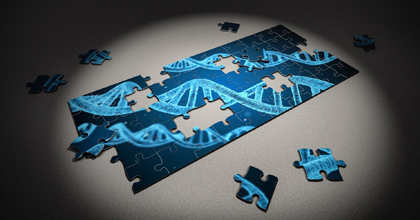A gene is a blueprint of a protein produced by a cell.

Epigenetics may be an unfamiliar to many, but it is one of the mechanisms by which genes are expressed, and my laboratory is conducting basic research on it.
What is a gene? In general, it often refers to a factor of a genetic trait transmitted from a parent to a child, but originally it means a design drawing of a protein written in DNA contained in the nucleus of a cell.
DNA is composed of substances with any of the four bases A, G, C, and T, and the combination of arrangements of the four bases determines the type of protein to be produced.
Humans have about 20,000 such combinations as genes. In other words, there are 20,000 genes producing 20,000 kinds of proteins.
Functions of protein are the most important in living organisms, including humans. Protein is produced by cells.
A human body is composed of 35 to 37 trillion cells, and these cells are divided into about 200 types. The difference is that each type of cells produces different proteins.
For example, beta-cells in the pancreas produce protein that becomes insulin, which is important for carbohydrate metabolism. One of the most abundant proteins in the human body, collagen, is produced by epidermal cells. However, epidermal cells do not produce insulin.
It sounds as if the DNA of epidermal cells contains a gene that produces collagen protein among the 20,000 genes and does not contain a gene that produces insulin protein. In fact, this is incorrect.
The DNA of every one of 37 trillion cells equally contains 20,000 genes. That means, epidermal cells also have genes that produce insulin protein. Why, then, do epidermal cells not produce insulin protein?
This is because cells that become epidermal cells are designed to express genes that produce collagen protein and to inhibit expression of genes that produce insulin protein.
In other words, genes are tagged with something like a sticky note to indicate on or off to notify each cell which gene to use or not to use. Depending on how genes are tagged, cells are classified into 200 types.
In humans, it is considered that several thousand kinds of genes are used in each cell. Some genes are commonly used in several types of cell, while there are also genes used only in one particular type of cell.
This mechanism of gene expression by sticky notes on every gene is called epigenetics.
There is a sticky note that controls gene expression
The DNA in which genes are written is very important for a living organism. If there is an alteration of information in DNA, a living organism could be mutated into a different form. That is the reason why they are kept in a safety box called cell nucleus.
When a cell produces protein, it does not directly use the precious DNA kept in the nucleus. In the case of humans, genes labeled with an “on” tag among the 20,000 in DNA are transcribed into RNA, which is like DNA but slightly different (this transcription refers to expression of the gene). Then the sequence of amino acids is determined from the information on the arrangement of bases in the transcribed RNA to produce various kinds of proteins.
Following this theory, you can change the expression of the genes if you can replace the tags instead of re-arranging or modifying genes in the DNA, which is kept in a safety box.
Of course, this sticky note is also important because it is copied during the course of cell division and contains the same sticky-note information in the same type of cells.
However, it has been found that the growth of human body and external factors such as stress can induce re-assignment of sticky notes.
That means, even though it is known that sticky notes are not absolute things, the mechanism by which they are reattached is still unknown.
However, in theory, it can be replaced artificially. So, what are we able to do?
There is a common misunderstanding about cancer cells that they are normal cells with mutated genes. However, the vast majority of cancer cells are produced owing to abnormal control of gene expression.
A mutation means that the information of a gene itself is broken or altered. But most cancer cells are originated from normal cells that cannot work properly because certain genes in these cells are tagged in wrong ways.
It is well known that cancer cells proliferate rapidly. In fact, cell division is controlled by sticky notes attached to genes. Cancer cells grow out of control owing to faulty sticky notes.
So, the runaway behavior of cancer cells can be stopped if we change the tag to repress the genes that work as an accelerator in cell division and to express the genes that play the role of a brake.
In fact, clinical trials of cancer treatments using such epigenetics are in progress. It is because we already know the enzymes that attach (remove) sticky notes.
The problem is that, with current technology, sticky notes on unspecified genes in normal cells surrounding cancer cells are also affected. In other words, adverse effects will occur.
However, in the case of a serious disease such as cancer, it is highly likely that a clinical trial medicine will come into practical use as a cancer control agent in case such adverse effects can be kept within an acceptable range.
Epigenetics may change healthcare

In recent years, iPS cells, regenerative medicine, and genetic modification technology have been attracting attention, and I think epigenetics will have an impact on these technologies.
For example, in an experiment in which ordinary cells are converted into pluripotent stem cells (iPS cell) that can grow into specific cells, a technique to implant genes that are desired to be expressed is used.
But the original ordinary cell also has its own genes. These genes are tagged with sticky notes that inhibit expression of pluripotency-related genes. But you can change the cell by changing the sticky notes.
In regenerative medicine using iPS cells, for example, when treating a damaged nerve, cells such as the skin of the person are collected. They are firstly converted into iPS cells that are capable of differentiating into various cells, then the iPS cells are converted into nerve cells.
However, if we can attach a desired sticky note to the genes of the targeted cell, it will be possible to convert the skin cells directly into nerve cells without going through the process of making iPS cells.
The same is true of genetic modification technology.
The genes in an organism hold the greatest potential of the organism, but they are not fully exercised.
So, even if other external genes are not introduced into a cell, you could activate one of the existing genes which is not used much and inhibit a certain other gene which is restricting it and then make crops stronger against pests or produce a lot of fruit without genetic modification.
What is more, we can apply epigenetics to more familiar problems.
For example, it has been found that, along with changes in the human body over time such as growing and aging, the way of attaching sticky notes that determine whether to use genes changes or becomes ambiguous. If this can be controlled artificially, it may be utilized in health and anti-aging care for the elderly.
It has also been found that the onset of lifestyle-related diseases is more likely when sticky notes that have been gradually changed to a certain extent exceeding the threshold level (Ikichi).
The cause such epigenetic changes is still unknown, but it has been revealed that if you continue to sprinkle ethanol on cultured cells, the sticky notes will change. In other words, there is a possibility that the position of the sticky note changes by placing stress on the cells.
If we can understand the mechanism of stress and people’s lifestyle, we will be able to identify the lifestyle habits that need to be improved by studying the changes in sticky notes, which will lead to the prevention of diseases.
Thus, epigenetics is involved in all human life, aging, diseases and death. Therefore, research to attach the desired sticky notes to targeted genes is being conducted throughout the world.
Such research is also being carried out actively in Japan. The growing interest of the public will also encourage such studies. I would be grateful if you could continue showing interest in reports on epigenetics in future.
* The information contained herein is current as of May 2020.
* The contents of articles on Meiji.net are based on the personal ideas and opinions of the author and do not indicate the official opinion of Meiji University.
* I work to achieve SDGs related to the educational and research themes that I am currently engaged in.
Information noted in the articles and videos, such as positions and affiliations, are current at the time of production.

